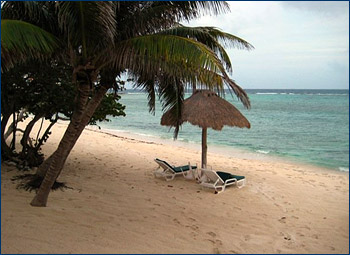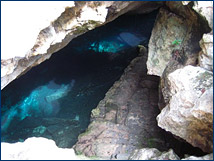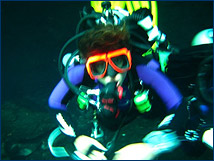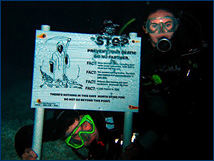
As you can see from this view of the "front yard" of their Akumal lodgings, Joey and the Texas A&M crew are really roughing it on this trip.
Remipedes and cave diving: Field notes from Joey Pakes
By UCMP grad student Joey Pakes, June 25–29, 2008
 As you can see from this view of the "front yard" of their Akumal lodgings, Joey and the Texas A&M crew are really roughing it on this trip. |
| Joey is a graduate student at UCMP currently doing research on remipedes, crustaceans that live in underwater caves and look a bit like centipedes. Her research requires SCUBA diving in these caves. Check out an introduction to Joey's research or her first field report. |
June 25, 2008: Arrival in Akumal
Yesterday I flew into Cancun airport to meet up with Professor Iliffe, my collaborator on the isotope project, and his research assistant Brett. With Iliffe were 13 of his Texas A&M students, most of whom I'd met last month in Florida, where they were completing their scientific diving and cavern courses. Now they will be spending the next two weeks attending a Tropical Marine Ecology course. By the time they leave, I will have explored some caves with and without them, and may even have sampled a bit. I will then stay on with Iliffe, Brett, and a researcher from Germany for five days of serious collecting. As I discussed in my introduction, I'll be collecting remipedes and their potential prey; tissue samples will be processed to determine carbon/nitrogen isotope ratios of the organisms. This will help me determine who is eating who in the food chain.
An hour's drive south along the coast brought us to Akumal in the state of Quintana Roo … and our lodgings for the duration of the trip, the Hacienda de la Tortuga (Guesthouse of the Turtle). The posh, condo-like suites are a bit cramped — I am sleeping on a couch so as not to share a bed — but the view more than makes up for it. "Field work" doesn't always mean tent camping and a lack of facilities!
Conservationists have marked the location of loggerhead and green turtle nests out on the beach. If we're lucky, we might awake in the middle of the night to find hatchling turtles making their way to the water by the light of the moon. During the turtle nesting period, tourists and locals alike make a conscious effort to keep lights off at night, either favoring the darkness or red-hued light bulbs — which are less likely to confuse the endangered turtles as to the direction of the moon, and therefore the ocean. Seeing some baby turtles would be a definite bonus!
June 29, 2008: Cenotes
Beneath the resorts, towns, and roads of the Yucatan Peninsula lies a vast and intricate web of underground rivers running through caves. The access points to these underwater caves are called cenotes — sinkholes generally made by the collapse of cave ceilings. Cenotes are not only an attraction for snorkelers and divers, they are also a major source of water in the Yucatan, in which there are no natural lakes or surface streams. The heavy use of cenotes for tourism, agriculture, and industry may lead to the demise of these beautiful habitats and their rare inhabitants.
The Yucatan's caves are mostly anchialine, having a distinct halocline — an abrupt junction of a less saline (and less dense) water mass with a more saline (and more dense) water mass. In some cases, there are multiple haloclines in these systems with each water layer more saline than the next as you descend into the cave.
Today I went to the cenotes in the nearby Choc Mool cave system (Sistema Choc Mool) for a couple of recreational dives. Before leaving for the site, I switched to a single tank setup, putting all of my hoses on the same regulator. I was diving with an aluminum (lightweight!) single tank and wearing my wetsuit, both of which make me more buoyant, so I strung four pounds of weight to my harness to make it easier to stay submerged.
Upon our arrival at the site with tanks and gear, we were greeted by a "ferocious" trio of guard dogs, still awkward and big-pawed with youth. These three puppies followed us around during setup and were especially loyal at lunchtime. I think we must have worn them out, because by the end of the day, they were content to just sit in the shade under the site's cement tables.
Choc Mool was filled with large boulders, tall rooms, and ledges that led to shallow rooms with loads of thin stalactites — all of it underwater. The stalactites hanging from the ceiling and stalagmites rising from the floor were all formed thousands of years ago when the caves were dry. Limestone caves are formed slowly over a period of thousands or millions of years by a chemical reaction between limestone and slightly acidified groundwater (a mild form of carbonic acid). The acidified water dissolves away the limestone as it invades cracks and fractures in the rock. Over time, narrow crevices can grow into large cavities and passages. If the ground water level falls below the level of the caves, the water will recede, leaving the caves dry. However, in these dry caves, surface water may still percolate through the limestone, producing stalactites and other speleothems (cave formations) as the water drips from the cave ceiling and minerals dissolved in the water precipitate out. The buildup of these minerals takes a very long time, but the structures that result can be magnificent.
 |
 |
 |
I felt pretty good during my first dive, gliding through passages and rooms with three students and our guide Brett. We saw quite a few cave shrimp (a species of Typhlatya) one of which was collected by Brett for later inspection. These animals are blind, but quick to jet away should they detect a disturbance in the water. This speed makes them quite hard to catch. I will certainly need some practice before I begin my own collecting.
Although everything today went as planned, I made mental notes of improvements that could be made before diving again. For example, I noticed that I was injecting a lot of air into my wing during the dive and had to release quite a bit as I surfaced, a signal that I was overweighted. Having had little experience SCUBA diving in freshwater, I underestimated how easy it is to sink in the top layer of cenote water, which is fresh or brackish. Also, by the time we hit the saltwater layer, the depth was great enough to compress my wetsuit and reduce its buoyant effect. For my second dive, I had removed two pounds, but next time I don't think I'll wear any extra weight at all.
I did have one problem: I was becoming quite dizzy as the dive progressed due to my blurred vision, a result of the disturbance of the halocline by the diver in line in front of me. To get some idea of what this blurriness was like, think about the swirly, rippling effect you might see as heat radiating from dark asphalt mixes with the cooler air above. On my second dive, I tried to avoid the disturbance by dipping into the warmer saltwater layer or ascending into the colder freshwater layer when possible. When it wasn't, I could at least move laterally away from the line of divers and swim through an undisturbed section of the cave. It's nice to be first through any section so that you can see the haloclines before you hit them — a beautiful sight resembling the surface of a glassy, calm lake without the reflections.
Dogs photo by Joey Pakes; all other photos by Ryan Morales.